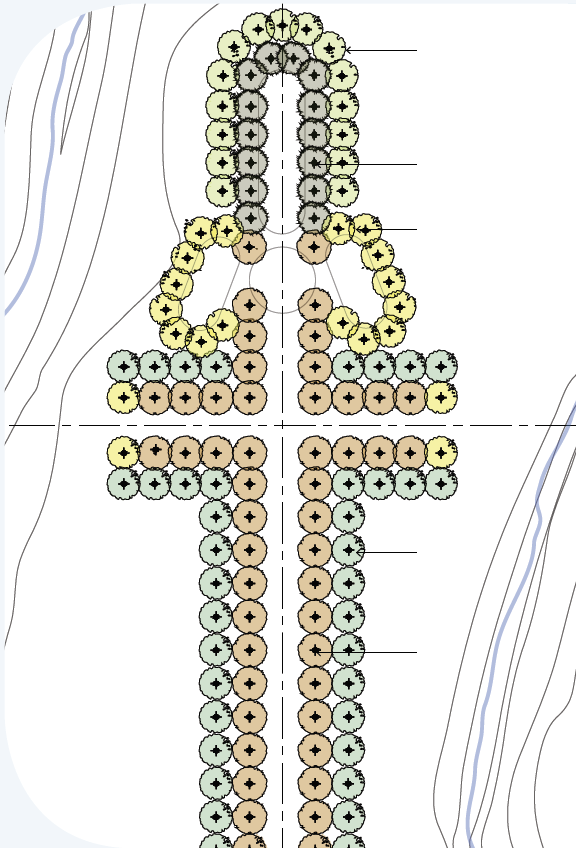Eastwoodhill tree cathedral
Rodney Faulkner, New Zealand Tree Grower August 2015.
One of the delightfully quirky features of Douglas Cook’s plantings at Eastwoodhill Arboretum is the cathedral at the bottom of Cabin Park. This area in 1935 was the horse paddock and it grew little more than poor grass and bracken. Douglas started planting groups of conifers to form the nucleus of the area that he was to call Cabin Park.
In 1936 Douglas and his wife Claire took a trip to Britain and it could well have been during this time he planned his very own tree cathedral, inspired possibly by the form of the great English cathedrals they would have seen on their travels. On his return he levelled a small ridge at the bottom of Cabin Park and planted trees in the form of a simple cross. Eucalyptus regnans form the pillars and Cupressus lawsoniana the walls and the chapter house, a circle of trees to the side of the main planting. The space between the great towering columns of eucalypts is what gives this area an almost spiritual atmosphere, even today when some of the original trees are showing signs of deterioration.
Many who visit the cathedral comment on the atmosphere created by a space within the planted forest, even more so when they discern the form of the cross which is still evident. Over the years numerous little ceremonies have been held in this special place including weddings, christenings, and quiet reflective meditations. However, many of the trees are in a state of gradual decline and it is time to consider and plan for a new tree cathedral and continue the vision Douglas Cook initiated 75 years ago.
New cathedral planning
The new tree cathedral will be located on a large flat within the arboretum, some distance along the Hihiroroa road and overlooked by the curator’s house. A small stream flows like a moat around three sides of the site and will eventually be bridged to allow walking access from the arboretum tracks. This project is part of the master plan which was developed by Nelson Byrd Woltz, the renowned landscape architect from the United States, and is the first of a number of developments to take Eastwoodhill forward into its second century.

Work on the site started after Christmas with felling and clearing some massive old poplars as well as many other tree and weed species that had taken over the stream edges. It was then time to start on the ground work with diggers and bulldozers making the most of the fine summer weather. The contractor transformed what had been an uneven, poorly drained rush-infested paddock into a smooth, well-drained space in the form of a raised cross. This is where the trees which will form the Cathedral design will be planted. The dimensions are the same as Westminster Abbey, 170 metres long and 70 metres wide at the widest point.
Planting
The ground work was completed and grass seed sown just before cyclone Pam headed in our direction in March so there were some anxious moments. At one stage it seemed we could expect rainfall similar to that in cyclone Bola. This could have caused serious damage to the recently worked ground but fortunately Eastwoodhill received only about 75 mm of warm gentle rain which was perfect for new grass establishment.
Selecting and obtaining the most appropriate tree species was the next step. Coastal redwood Sequoia sempervirens will form the main aisle and large leaf lime Tilia platyphyllos will create a deciduous wall beyond the redwoods. The central aisle will be 12 metres wide and the redwoods on each side will be high pruned as they age to replicate the massive pillars of a cathedral with their interlinking branches forming the vaulting of the roof. Several other species will be used to provide contrasting textures and seasonal colour to main areas such as the two small chapels on each side beyond the cross.
The trees will be planted this winter and fenced off from the rest of the site to enable sheep to be grazed while the trees grow to a safe height. This could take five or more years. It is hoped that within ten years ceremonies can be held in some of the cathedral spaces, by when the site will be linked to the walking track network by two bridges across the stream at each end of the cathedral.
The site was officially blessed by representatives of many of the churches on Arbour Day, 7 June 2015, and there was a ceremonial planting of the first trees, a pair of common yew Taxus baccata.

 Farm Forestry New Zealand
Farm Forestry New Zealand